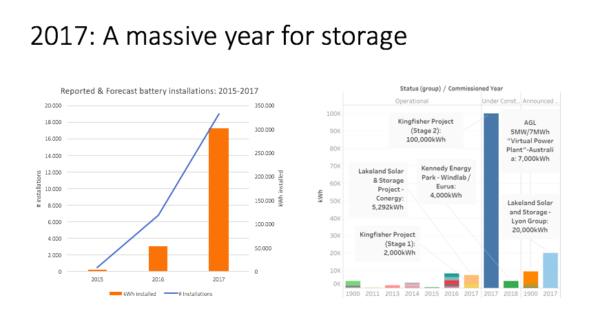This week in partnership with Australia’s Chief Scientist Alan Finkel, the Australian Council of Learned Academies (ACOLA) released a report on the future of energy storage in Australia. The report identifies battery storage as an important emerging industry globally and the vital link between energy production and consumption in Australia.
For homeowners who can afford a rooftop solar array, battery storage has the potential to reduce electricity costs and provide them with increased independence from electricity retailers. Some battery systems can provide households with backup power in event of a blackout – an inconvenient, but fortunately infrequent occurrence in most parts of Australia.
The cost of home batteries has reduced significantly over the past decade and Australian consumers are purchasing and installing distributed storage in rapidly increasing numbers. SunWiz reports that while around 3,500 distributed batteries were purchased in Australia in 2016, that number is set to surge past 14,000 this year – and this is on the conservative side.
 A Climate Council poll in September found that 68% of respondents who already have PV panels installed on their roofs would consider battery storage in the future. Whilst their interest levels may be high, potential buyers will need do extensive research to decide if a battery is worth the substantial upfront cost.
A Climate Council poll in September found that 68% of respondents who already have PV panels installed on their roofs would consider battery storage in the future. Whilst their interest levels may be high, potential buyers will need do extensive research to decide if a battery is worth the substantial upfront cost.
For homes that have substantial electricity requirements during peak electricity pricing hours (usually in the evening and early morning) a battery can provide a cheap alternative to drawing electricity from the main grid. For home owners who don’t have high energy requirements, a battery may not provide a return on investment.
How much consumers will save through installing a battery will differ between states and territories due to variations in electricity prices (including peak and off-peak electricity costs), connection fees, feed-in tariffs, seasonal electricity requirements and household consumption during peak periods. Savings should be considered against the cost of purchasing and installing a battery and upgrading current PV hardware. To do these calculations correctly is not a simple task.
Battery prices vary depending on power output, total storage capacity and warranty times. Tesla’s Powerwall 2, which provides 13.5kWh of energy storage capacity, is the most in-demand home battery unit in Australia today and costs $8750, not including installation fees.
Manufacturers selling home batteries in Australia place a 10-year or shorter manufacturing warranty on their hardware which, according to SunWiz Consultants, is the approximate time it currently takes for a home to pay off the installation of a battery. While batteries may last longer than their ten-year warranty, they suffer from degradation over time. Replacement frequency and costs need to be considered when purchasing a battery unit.
Battery installation costs can be high because a renewable energy system requires a specialised inverter to connect PV panels to the battery and the battery to the house. While existing PV systems already have an inverter (to convert DC power from panels to AC power consumed at home) older models may not be compatible with a battery. A new or additional inverter will be required to convert AC power in the home to DC power for energy storage.
How much electricity solar arrays produce changes day-by-day and season-by-season. Even on a good day, home PV arrays may not provide enough excess electricity to charge even a small battery. Homeowners will need to calculate how much excess their PV array is currently making to inform whether a battery is worth the investment, and if so, what size battery can service household needs. Or, homeowners can install more PV panels to produce enough excess electricity that can be stored and used during peak periods.
Calculating usage is a complex exercise that must take into consideration daily electricity production and household patterns of use over a year. Homeowners may be able to calculate how much excess their PV array is currently making from their feed-in tariff.
While some consumers may dream of separating completely from the grid, most homeowners will still require extra electricity during periods of low generation. Only residents with a very large solar energy system (PV+ battery) will be able to generate enough power to operate independently. This is particularly the case for Australian homes located in areas of the country that have low sun exposure for longer periods of the year, such as in Victoria or Tasmania.
For new customers of solar energy, technology can be confusing, and information hard-to-navigate. ACOLA reports that, for people who can afford to buy a battery, not everyone has the technical knowhow, motivation or interest to do so.
A national survey undertaken by ACOLA found that 38% of respondents did not know enough about battery storage to make a decision about purchasing one.
One recent PV customer, an engineer, told pv magazine Australia that high electricity prices prompted her family to look for cheaper sources of energy. “I originally heard about how to install PV panels from friend. She suggested that I go on the Solar Quotes website because that’s what everyone does. From there I got three quotes and two companies sent out representatives to explain how solar installation works.”
One of the representatives was very knowledgeable and she considered their service to be very good because she was able to ask many questions. Without background knowledge in science or engineering, she admits that the everyday home installer would have to trust what they’re being told by sales representatives.
“My husband isn’t an engineer and if I wasn’t there he wouldn’t have asked the questions that I did. We knew we wanted to install good quality panels and an inverter that would be compatible with a battery in the future. We also wanted to make sure our panels were producing enough output required for a battery.”
Getting the right renewable energy system at the outset gives customers more options when setting up a battery unit in the future. The engineer’s intention is to monitor her family’s electricity usage and decide whether or not a battery would be economically viable in the future. She admits that the marketplace can be very confusing and most customers are relying on word-of-mouth for information as well as recommendations from company representatives.
This article was updated on 27/11 to merge parts I and II and to include additional information and analysis.
This content is protected by copyright and may not be reused. If you want to cooperate with us and would like to reuse some of our content, please contact: editors@pv-magazine.com.








I believe that potential users (homeowners) are befuddled by the complexity (and deception) of the storage batteries offered, which are typically Lithium.
For a start, in Australia, Lithiums are classified as hazardous, and are not to be installed within the dwelling. Then there is the degradation of capacity over time, exacerbated by a high level of charging (SOC), and also by moderate to higher levels of discharge (DOD). And temperature is the biggest negative influence on degradation of all, with a temperature of 32degC bringing capacity down to 70% in 5 years even before the other two factors are taken into account. Sure, they offer 10 year warranty on workmanship, but you end up with batteries that have perhaps only 10% of capacity left … next to useless.
At the same time, the Australian invented vanadium batteries (VRB) last for over 20 years, are unaffected by time or heat (no “water cooling system” required!), can be discharged 100% with no affect on battery life , and are safe, and replenishable and expandable by adding fresh liquid electrolyte. Also the LOCE (levelised cost of energy per kWH) can be a fraction ( a fifth) of the cost of Lithium.
This really is THE solution for significant energy storage, allowing not just independence from the grid, but also the opportunity to sell excess energy via blockchain technology to other users (being trialed by PowerLedger in Fremantle presently).